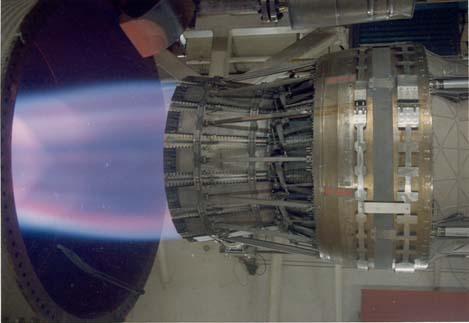Eng ineers at the Air Force’s Arnold Engineering Development Center on the grounds of Arnold AFB, Tenn., began running Pratt & Whitney’s F100 fighter engine April 29 on the synthetic fuel blend that the service wants its entire fleet capable of using by 2011. The tests of the F100, which powers the F-15 and versions of the F-16, took place in a test cell that simulates supersonic and high-altitude conditions. The F100 is the first fighter engine tested with the fuel mix, which is comprised half of traditional JP-8 aviation fuel and half of a synthetic paraffinic kerosene, or SPK. The latter is derived from natural gas or coal via the Fischer-Tropsch refining process that was developed in Germany in the 1920s. USAF is in the process of certifying its various platform-engine combinations to operate with the fuel blend. Already the service has certified the B-52H bomber and is well along in the process of clearing the C-17 to use the fuel. A B-1B bomber made its inaugural flight March 19 with the fuel blend. That flight marked the first time that a high-performance, afterburning engine—in this case, General Electric’s F101 powerplant—burned the synthetic mix in flight. (Arnold report by Janae Daniels)
ineers at the Air Force’s Arnold Engineering Development Center on the grounds of Arnold AFB, Tenn., began running Pratt & Whitney’s F100 fighter engine April 29 on the synthetic fuel blend that the service wants its entire fleet capable of using by 2011. The tests of the F100, which powers the F-15 and versions of the F-16, took place in a test cell that simulates supersonic and high-altitude conditions. The F100 is the first fighter engine tested with the fuel mix, which is comprised half of traditional JP-8 aviation fuel and half of a synthetic paraffinic kerosene, or SPK. The latter is derived from natural gas or coal via the Fischer-Tropsch refining process that was developed in Germany in the 1920s. USAF is in the process of certifying its various platform-engine combinations to operate with the fuel blend. Already the service has certified the B-52H bomber and is well along in the process of clearing the C-17 to use the fuel. A B-1B bomber made its inaugural flight March 19 with the fuel blend. That flight marked the first time that a high-performance, afterburning engine—in this case, General Electric’s F101 powerplant—burned the synthetic mix in flight. (Arnold report by Janae Daniels)
The U.S. began extensive air and artillery strikes against Islamic State group targets in Syria on Dec. 19 in retaliation for the killing of three Americans on Dec. 13 by a gunman affiliated with ISIS, U.S. officials said.

